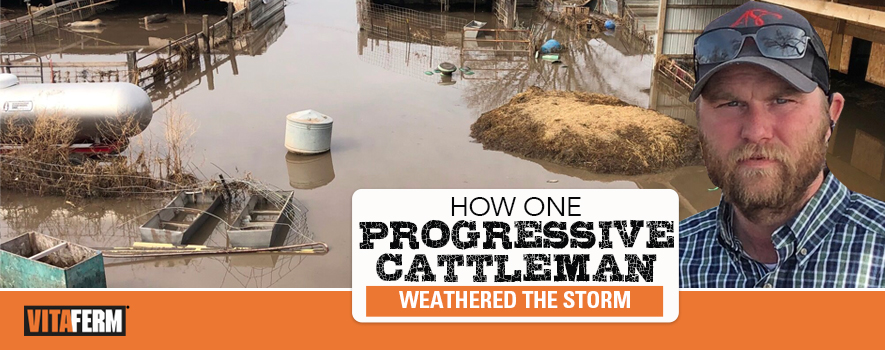
Livestock producers from across the country are reeling from the wrath of Mother Nature. From record rainfall amounts, to early-season tornadoes in the South, prolonged winter in the North, and the worst storm to ever hit Nebraska with the blizzard and floods from the “bomb cyclone” in March, producers could easily give up. But that is not the spirit engrained into those involved in American agriculture. Livestock producers, farmers and ranchers have long lived under the premise that taking care of the land and livestock is more than a job, it’s a passion for many, and if they take care of their resources, those resources will take care of them.
Eric Alberts, Fremont, Neb., is one livestock producer who knows just how fast and furious those mid-March floods hit. He and his dad own and operate Alberts Swine and Cattle, a commercial hog and cattle operation. Alberts also runs a registered SimAngus operation, Front Pasture Cattle Co. He relies on embryo transfer and artificial insemination to produce high-quality females to market in his fall sales.
When the torrential rains and flood waters hit the Alberts’ farm in March, they didn’t have much time to act, but they did have time to move their cattle. They got them moved to some higher ground, but with more than 800 pigs, they couldn’t get them relocated.
“We left some recips and 36 feeder cattle behind, but they all had big mounds to get on,” Alberts said. “Cows were easy to move; the hogs weren’t.”
After the waters receded and Alberts and his dad started accessing the damage, the gut-wrenching reality set in. They had lost 805 pigs in the flood waters. However, out of all their cattle, only one cow and four calves died due to the effects of the flood. He remains optimistic with plans to rebuild and is already moving forward.
“Dad wants pigs back yesterday. I’ve got to rebuild buildings. He’s impatient, and I’m trying to be patient. I was always told if you own livestock, you own dead stock. You just have to stay positive with it because that is part of the gamble,” Alberts said.
One thing that he won’t gamble with is his cattle’s nutrition program. Even during challenging times, he knows the value of a high-quality nutrition program, and how taking care of his cattle will return dividends in increased conception and more live, healthy calves and healthier cows.
He’s on his second season of feeding VitaFerm® Concept•Aid® 5/S 60-90 days before he starts calving through breeding. Once his cows go to summer grass, he transitions them to VitaFerm HEAT®. Alberts said he has seen a significant increase in his conception rates, and across all technologies he has nearly 95% conception in his herd.
“I’ve noticed a big difference with the natural service, A.I. and embryo conception rates. So, I’m a fan of it. There’s a lot of things you can cut back on in the cow herd to save money when times are tough, but mineral is the last thing you should cut out because if your cows aren’t getting their mineral or vitamins, they aren’t breeding back, and you’re never going to have anything to begin with. In my eyes, they’ve got to have good mineral every day, 365 days a year. It’s for conception, for health and the health of their calf,” Alberts said.
He and his neighbor run cattle together and market their cattle through production and online sales together. Alberts told his neighbor if they were going to continue to run them in the same pastures, he would have to upgrade his mineral program to the VitaFerm minerals. His neighbor balked at writing the check and investing in that type of mineral program. Alberts worked an agreement, where he pays for all the mineral and his neighbor covers other management costs, a win for both partners. Alberts said he includes the VitaFerm Concept•Aid 5/S right into his feed ration, at the recommended rates to ensure his cows are getting all the vitamins, minerals and Amaferm® they need to thrive. Amaferm®️ is a prebiotic designed to enhance digestibility by amplifying the nutrient supply for maximum performance. It is research-proven to increase intake, digestion and absorption.
“If you get 10 more cows to breed and wean off 10 more calves, that pays for your mineral pretty quick. I have my ways to save money but slacking on a mineral program isn’t one of them,” Alberts said.
The bomb cyclone and the winter of 2019 will not soon be forgotten. But livestock producers like Eric Alberts know there is no time for self-pity, and that perseverance pays. Less than a month after the worst storm in his state’s history, he is rebuilding his farm and focused on next year’s calf crop. He has already A.I. bred nearly 60 head, and started his embryo transfer program, which will include 28 recips this year.
“You just roll with it. No sense getting down in the dumps about it.”
Alberts remains optimistic. He knows that as he continues to take care of his herd, providing them with the best nutrition possible, they will continue to take care of him. And that is care that comes full circle.


